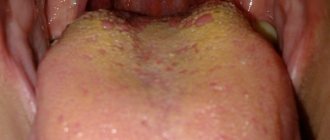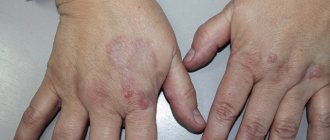White dots, spots or a dense film located on the surface of the tongue are a very ambiguous symptom. Firstly, they vary in appearance. Secondly, some of the formations cause pain, while others are completely painless. Many people mistakenly believe that the absence of pain means the absence of something serious. However, this is not always the case.
- White coating on the tongue: when is it normal and when is it pathological?
- What diseases does a white coated tongue indicate in adults?
- White plaque on a baby
- How to get rid of white plaque on the tongue at home
Of course, there are completely harmless explanations for the white coating on the tongue. For example, moderate dehydration or simple digestive disorders. However, in some cases, a white tongue may indicate a precancerous condition. This article is intended for anyone who has discovered strange spots on their own tongue or the tongue of their child. Let's look at the most common causes of white plaque on the tongue and under the tongue in adults and children, and give recommendations on what to do in such cases.
A child has a white coating on the tongue at fever: causes and methods of treatment
The tongue is not only an auxiliary organ for swallowing food, but also a means of diagnosing the presence of diseases.
Our ancestors used language to identify previous diseases, which made it possible to eliminate them in a timely manner. Until the tongue acquired its natural color, the treatment procedure was considered incomplete. If a white coating forms on the surface of the tongue, this indicates various disorders. The causes of plaque can be pathologies, infections, or simply failure to comply with hygiene requirements. What does a white coating on the surface of the tongue mean in children, as well as ways to eliminate these signs, we will find out further.
What color should a child's tongue be?
Initially, it should be noted that the presence of a white coating on the surface of the tongue does not in all cases indicate a disorder. To find out the causes and the need for treatment, you need to consult a doctor.
A pale pink color of the tongue in children is considered normal. But not even in all cases, this color of a given organ indicates that the child is absolutely healthy. Factors such as the mobility of the organ, as well as its unhindered and unimpeded movement, are also important. The condition of the organ is influenced by factors such as humidity and temperature in the room where the child spends time. Parents cannot independently prescribe treatment for their child if they detect signs of a white coating on the tongue. White coating on a child’s tongue is not dangerous in the following cases:
- If signs of whitishness on the surface of the organ are detected in the morning after sleep. If this plaque is easily cleaned with a toothbrush, then it is not dangerous and does not indicate disease.
- Whitishness of the organ can appear in infants and newborns after breastfeeding or artificial feeding.
- In some cases, a whitish coating on the tongue is allowed if the thickness of the coating layer is insignificant.
It is important to know! If parents cannot independently determine whether a white coating on the tongue indicates a disease, they need to consult a doctor.
Next, we will consider the main reasons that may indicate the formation of a white coating on a child’s tongue.
Inflammatory processes in the mouth
One of the main reasons for the formation of a white coating on a baby’s tongue may be the development of inflammatory processes. Such inflammatory processes include ailments such as stomatitis, caries, and fungus. Stomatitis manifests itself in the form of a white coating not only on the tongue, but also on the tonsils and the inner surface of the cheeks. The main sign of stomatitis is the presence of white dots with grains. If you try to remove these grains mechanically, then signs of blood appear. The following symptoms are characteristic of stomatitis:
- lethargy and weakness;
- soreness in the oral cavity;
- decreased appetite;
- whitish coating on the tongue;
- temperature increase to 39 degrees.
A high temperature in a child with signs of a white coating on the tongue can manifest itself not only with stomatitis, therefore, to clarify the diagnosis, you need to show the child to a doctor.
If the cause of the appearance of white plaque is the presence of fungal diseases, then the following symptoms develop:
- dry mouth;
- formation of plaques and papules;
- redness of the mucous membrane;
- signs of severe itching;
- a slight increase in temperature up to 38 degrees is allowed.
If the fungal disease progresses to the stage of complications, then the child’s temperature may rise to 39-40 degrees, as a result of which it is necessary to resort to the use of antipyretic drugs. Some of the most common fungal diseases of the oral cavity are candidiasis and thrush.
Plaque on the surface of the tongue can cause dental disease such as caries. Often, this reason for the appearance of whitish on the tongue occurs in children over the age of 6 years, if children do not take care of oral hygiene and do not brush their teeth. You can eliminate caries and inflammatory processes in the tongue by visiting a dentist. It is important to note that with caries the child’s body temperature does not increase.
Respiratory diseases
Plaque on the tongue may indicate the presence of diseases of the respiratory system. Most often, such pathologies arise through a viral or bacterial infection entering the body.
If a virus infects the body, it contributes to the development of diseases such as influenza and ARVI. Moreover, the main sign of such colds is an increase in temperature above 39 degrees. Colds manifest themselves as the development of symptoms of cough, runny nose and redness of the throat. If you have such symptoms, you should definitely visit a doctor.
The presence of a white coating on the tongue in the front part indicates that the development of bronchitis cannot be ruled out. With bronchitis, the signs of plaque become foamy, which already indicates the need to visit the hospital. The main symptom of bronchitis is a sign of fever. Moreover, its values may increase due to the development of complications.
Signs of a white tongue in a child may precede the development of diseases such as pharyngitis or laryngitis. With these diseases, a white coating reveals not only the surface of the tongue, but also the tonsils. White coating on the tongue of a child with pharyngitis and laryngitis also precedes an increase in body temperature.
Plaque and infectious diseases
If an infectious type of illness develops in the body, it is also not recommended to self-medicate at home. For infectious diseases, the main symptom is a sharp increase in body temperature. A white coating forms on the tongue, which is characterized by a thick and high-density consistency. Infectious diseases in children include:
- Scarlet fever, which is an infectious form of the disease, manifests itself in the form of white and red spots on the tongue. This disease is also characterized by symptoms such as the appearance of a rash on the skin, redness of the throat, strong signs of intoxication, and enlarged lymph nodes.
- Diphtheria. It manifests itself in the form of damage to different areas in the oral cavity. The main symptom of diphtheria is the formation of white spots on the tonsils, and the tongue is covered with a whitish coating with a serous base. The disease is characterized by a transition to an acute form, as well as spread through contact.
Plaque on the tongue: a sign of gastrointestinal diseases
Only a qualified doctor can make an accurate diagnosis after examining a small patient, as well as after receiving the results of a scraping analysis. White plaque may also indicate the presence of gastrointestinal diseases, such as gastritis. Gastritis is caused by such symptoms as the formation of plaque in the central part of the tongue with the appearance of cracks and grooves at the extreme base.
Read also: Why do children's baby teeth turn black?
It is important to know! The plaque can be not only white, but also brownish, which also indicates gastritis.
In addition to gastritis, white plaque can appear with a disease such as dysbiosis. This disease is especially relevant among children under the age of 1 year, while the process of establishing the functioning of the stomach is observed. Dysbacteriosis is characterized by symptoms such as the appearance of severe cutting pain, weight loss, and rashes all over the body. The body temperature rises to 38 degrees, but it should be brought down if its value exceeds the limits of 39 degrees.
When signs of white plaque are found on the tongue in its root part, this means a symptom of the disease enterocolitis. Enterocolitis is an inflammatory process that develops directly in the intestines. Characteristic symptoms of the disease are:
- heat;
- excessive gas formation;
- diarrhea and constipation;
- the presence of blood in the stool;
- stomach ache.
It is important to know! If there are signs of gastrointestinal disease, you should consult a gastroenterologist.
Diseases that may be symptomatic of plaque accumulation
There are conditions under which plaque can coat the tongue even with regular hygiene.
These include:
Oral lichen
Dermatosis, accompanied by the appearance of individual white spots and nodules in the mouth (on the tongue, gums, palate, tonsils, inner surface of the cheeks, which subsequently merge into a single “lace pattern.” The rash may be accompanied by other symptoms, for example, burning and dryness of the oral mucosa.
Leukoplakia
The disease provokes the appearance of large white spots on the tongue and other parts of the oral cavity. Leukoplakia is usually caused by irritants such as tobacco and alcohol, but it can also occur as a reaction to inflammation in the mouth or wearing dentures.
The plaque that forms due to leukoplakia is harmless in itself. But sometimes complications still arise, so you should definitely consult a doctor.
Oral thrush
A fungal infection caused by yeast-like fungi of the genus Candida. Its oral form is often found in newborns and infants and is accompanied by a white or yellowish cheesy coating in the mouth and tongue.
People with weak immune systems (for example, after taking antibiotics or chemotherapy), asthma and diabetes have a high predisposition to oral thrush. Wearing dentures and poor hygiene can also provoke the development of oral candidiasis.
Oral syphilis
An infection transmitted by oral, sexual and household means, which is accompanied by the appearance of white chancre ulcers on the inner surface of the cheeks, lips, gums or tongue. Syphilis in humans is extremely contagious and requires mandatory treatment, as it can cause serious complications, including death.
Oral cancer
The disease may be accompanied by white or red spots, ulcers on the lining of the gums, lips, cheeks, tongue or tonsils, pain or loss of sensation in areas of the mouth. It requires an urgent visit to the doctor, since it threatens not only health, but also human life.
Chronic inflammatory diseases in the mouth
Plaque on the oral mucosa can be accompanied by gingivitis, stomatitis, periodontitis, tonsillitis, tonsillitis and other chronic diseases. For an accurate diagnosis, you should consult a dentist and therapist.
If the symptoms you observe do not disappear during thorough brushing of your teeth or return immediately after performing hygiene procedures, be sure to visit your dentist. If you experience other symptoms along with the plaque, make an appointment with a therapist, as you will need a detailed diagnosis of your health condition.
https://youtu.be/Y-v9YnVDZ2c
Features of eliminating white plaque
If a child develops symptoms of a white coating on the tongue and an increase in temperature, then there is no need to delay; you must immediately go to the hospital. This will help eliminate the development of complications and prevent serious consequences in a timely manner. To combat white plaque, you must first identify the reasons for its formation.
- If the cause of the development of this symptom is fungal diseases, then soda solutions are used to combat the disease, with which the oral cavity is treated. This method is used to treat children under one year of age.
- Children aged 1 year and older are treated with lotions made from a solution of water and honey. Lotions are made 2-3 times a day for a period until the symptoms disappear.
- If the factors of white plaque on the tongue are caused by viral and bacterial infections, then to eliminate them they resort to the use of antiviral or antibacterial drugs. To eliminate white plaque on the tongue, various solutions with analgesic and wound-healing properties are used.
- For older children, medications with an antiseptic principle of action are used.
To summarize, it should be noted that the presence of plaque on the tongue is one of the best signs for the timely diagnosis of the disease. It’s not for nothing that every visit to the pediatrician begins with the doctor examining the oral cavity.
Treatment methods
To eliminate the circumstances causing discomfort and burning tongue syndrome, you need to undergo a therapeutic course.
Drug therapy
Treatment is selected individually, but contains a general list of actions aimed at recovery:
- treatment of affected areas with antiseptics with the effect of anesthesia and elimination of pathogenic microbes (Octenisept, Metrogyl Denta, Miramistin);
- careful care of the oral cavity by rinsing with baking soda, decoctions of healing herbs (chamomile, calendula, celandine, St. John's wort) and applications using sea buckthorn, rose hip, and peach oils (help healing and tissue regeneration);
- in case of an allergic reaction, you need to stop using medications containing a possible allergen and take antihistamines and enterosorbents;
- in case of metabolic dilemmas, a course of vitamin therapy is required;
- if the syndrome is caused by an infection, you should start taking bactericidal and antiviral agents;
- if there is a stone on the teeth, perform hygienic procedures to remove it correctly and carefully;
- drinking regime of at least 1.5 liters of water per day (if there is no kidney pathology).
ethnoscience
In general therapy, you can also resort to traditional methods of healing the oral cavity, which have soothing, antimicrobial, analgesic, healing and disinfecting properties.
- Oak bark decoction .
Bring 20 g per ml of water to a boil, infuse and strain. Rinse with the purchased substance every 4 hours a day. - A decoction of dried chamomile, St. John's wort or immortelle plants . 1 tsp. in a glass of boiling water, leave for about 15 minutes. Rinse your mouth with the substance up to 3 times a day.
- Cottage cheese with sour cream . Mix, wrap in gauze and apply to the tongue for 5 hours.
- Peach and rosehip oil . Lubricate the surface of the tongue.
- Strong greenish tea.
1 tbsp. l. per glass of water, brew and leave covered for 1 hour. Rinse at intervals of hours.
- Soda-salt solution. 1 tsp per glass of water. baking soda and sea salt.
Mix well and rinse every 2 hours.
White coating on the tongue, causes
Most healthy people have a white coating on the tongue in the morning. During the night, bacteria accumulate on the surface of the tongue, and they form a thin transparent coating through which the tongue is clearly visible. In a healthy person, the tongue is covered with a light coating that does not have an unpleasant odor, is easily removed from its surface and does not appear again for a long time.
But if you constantly have a thick coating on your tongue with an unpleasant odor, it is difficult to remove, and after removal it quickly recovers, then this is a serious cause for concern. We will tell you why your tongue is white in the morning, what diseases a white coating can signal, and how to treat it.
- Why does white plaque form?
- Treatment of white plaque on the tongue
- White plaque and temperature
- White tongue is a sign of disease
Causes of white coating on the tongue. Why is it formed?
White coating on the tongue. Why does a white coating appear on the tongue
? As already mentioned, it is formed as a result of the accumulation of bacteria and their metabolic products on its surface. The mouth of every healthy person is home to millions of different bacteria, both beneficial and pathogenic. They actively reproduce and take part in the process of digesting food. Remains of bacteria accumulate on the surface of the tongue, teeth and gums, from where they are removed during hygiene procedures. Thorough cleaning of the surface of the teeth, gums and tongue with a toothbrush and toothpaste can almost completely get rid of plaque. Of course, during the day it will form and accumulate again, so you should brush your teeth twice a day.
A tongue with a white coating can tell a lot about your health. Its reasons can be very diverse:
- First of all, a white tongue
indicates a decrease in immunity, as a result of which pathogenic bacteria actively multiply in the oral cavity, which settle on the surface of the tongue in the form of a white and grayish coating. - The most common reason why white plaque forms is diseases of the gastrointestinal tract. In this case, the tongue is covered with a white coating in the middle part, sometimes the white color is accompanied by the formation of cracks. Such symptoms most likely indicate the initial stage of gastritis. If there are no other alarming symptoms, then it is enough to adjust the diet, and over time, the coating on the tongue will disappear on its own, and your health will noticeably improve.
- Teeth prints and white coating on the tongue are a sign of insufficient digestibility of the intestines. In this case, you need to contact a gastroenterologist for advice, further examination and treatment.
- A white coating on the tip of the tongue or along the edges of the front appears if there are respiratory diseases. Very often such plaque occurs from smoking.
- White plaque on the root of the tongue, especially on the lateral surfaces of the back, signals impending problems with the kidneys.
- Enlarged white papillae, a strong white coating and a dry tongue indicate severe dehydration. In this case, it is recommended to drink plenty of fluids, and in case of excessive dryness of the tongue, you should consult a doctor for help.
- A white, cheesy coating on the tongue is a sign of fungal diseases, in particular candidiasis or thrush. Most often, this disease affects young children, but adults are also susceptible to it.
- A thick, dense white coating also occurs with sore throat. In this case, it is accompanied by elevated body temperature, difficulty swallowing and other symptoms of ARVI.
Read also: White sores on a child’s tongue
Drug treatment
Modern treatment methods are slightly different from those used previously. If we talk about drug treatment at the first signs of ARVI, then preference is given to the following drugs:
- Anti-inflammatory drugs: Ibuprofen, Paracetamol, Diclofenac. However, they should only be used if the body temperature has risen above 38 degrees.
- Antihistamines that easily remove the symptoms of a cold, including nasal congestion, swelling of the mucous membranes, etc.
- Medicinal nasal drops. They are used to increase the flow of fluid from the sinuses.
- Remedies for sore throat. For example, “Septolete Neo”, “Strepsils”, “Hexoral”, “Lizobakt”, “Tantum Verde”. All these drugs have an anti-inflammatory and antimicrobial effect, thanks to which they successfully fight pain in the throat.
- Cough remedies. For example, “Stoptussin”, “Thermopsis”, “Mukaltin”, “Ambroxol”, etc. All these drugs have an anti-inflammatory effect with an expectorant effect.
Diclofenac is used if the temperature cannot be brought down on its own.
With the help of such drug treatment, you can stop the spread of respiratory infections at the very beginning, which will allow you to avoid complications and other unpleasant moments.
Treatment of white plaque on the tongue
Cleaning white plaque from the tongue
. White plaque on the tongue and under it is not an independent disease, so treatment should be aimed not so much at getting rid of the plaque, but at identifying and eliminating the cause of its formation.
How to treat white coating on the tongue? If you find it in yourself, treatment can only be prescribed after a thorough examination by a doctor. In some cases, drug treatment may not be needed at all. If incipient gastritis is detected in a timely manner, you can get rid of it with the help of a special diet.
Very often, patients are interested in which doctor to go to if a white plaque is detected. It is best to start with a general practitioner; he will examine the surface of the tongue, determine the color and density of plaque, and at the same time ask you about your general health, on the basis of which he can draw certain conclusions about the state of your health. Next, the therapist can give a referral for a more thorough examination by a gastroenterologist if there are suspicions of disturbances in the functioning of the digestive system.
After eliminating the underlying disease, plaque on the tongue disappears on its own some time after completion of treatment and correction of the nutritional system.
Often a white coating forms due to candidiasis or thrush. In this case, the plaque is dense, cheesy and difficult to remove. You cannot treat fungal infections on your own; you should consult a dermatologist.
Treatment of pathology
It is clear that plaque on the tongue is a symptom of some disease that needs to be treated. As mentioned, there are many diseases accompanied by such a symptom, and their treatment is different. It is pointless to independently treat a coated tongue until the cause of its appearance is eliminated and it will not be possible to get rid of it.
If you have already found out the cause and started treatment, you can simply speed up the process of clearing your tongue. There are several ways to do this.
- Cleansing with a bandage. Wrap your index finger in a sterile bandage and begin cleaning your tongue from root to tip. Do not press too hard on the root - you can cause a gag reflex; do everything gently, trying not to scratch the receptors of the tongue. After each movement of your finger from root to tip, rinse the bandage in an infusion of calendula or chamomile.
- There is a special device for cleaning the tongue; it must be used very carefully, as there is a risk of damaging the mucous membrane.
- Vegetable oil cleanses the tongue well of plaque; it also removes toxins from the salivary glands. For the procedure, you need to put 2 tsp in your mouth. vegetable oil and dissolve it. I must say that the procedure is not pleasant, but it is very effective. The oil should be spat out after 10-15 minutes, it should turn white, if you removed the oil earlier and it remained the same as it was, then you did everything in vain. This procedure should be done on an empty stomach several times a month.
- Honey is a natural disinfectant. You can buy propolis tincture at the pharmacy, mix a few drops with a glass of boiled water and rinse your mouth every day. You can chew propolis for 5 minutes. These manipulations should be done 1-2 times a week.
- Baking soda will get rid of microorganisms accumulated in your mouth. It removes hard plaque well; for this you need 3 tbsp. l. dissolve soda in a glass of boiled water and rinse your mouth with the resulting solution. You can soak a toothbrush in baking soda and gently, without pressing, clean your tongue.
Temperature and white coating
Temperature and a white coating on the tongue may indicate an incipient sore throat. In this case, patients complain of a coated white tongue, pain when swallowing, general weakness and malaise, as well as fever. The combination of these symptoms provides grounds for diagnosing angina.
With a sore throat, the tongue becomes white and the throat hurts, while the plaque is usually very dense and difficult to remove. Taking certain medications only worsens the condition. Therefore, it is extremely important to ensure oral hygiene, to clean not only the teeth and gums, but also the tongue from plaque.
Advice! You can remove white plaque using an ordinary soft toothbrush and toothpaste. Use light circular movements to clean the surface of the tongue, being careful not to damage or scratch it. It is best to do this procedure in the morning before eating, since the plaque consists almost entirely of bacteria, and it is completely undesirable to swallow them.
Parents' actions
In cases where a white coating appears on a child’s tongue only in the morning or after eating dairy food, is easily removed and does not return during the day, this should not cause concern to parents.
For infants and children under one year of age, plaque from the tongue can be removed with a finger wrapped in a piece of clean gauze or bandage. Finger movements must be careful. For older children, plaque is removed from the tongue using a soft toothbrush. It is safe for children of any age to treat the oral cavity with a soda solution.
For a child over 3 years old, the solution is used as a rinse; for younger children, the tongue is wiped with a gauze swab dipped in a soda solution.
If the white coating is difficult to clean off from the surface of the tongue, does not disappear within several days, or is accompanied by a burning sensation and painful sensations, parents should show the child to the doctors. These may be specialists such as a dentist, pediatrician, gastroenterologist.
Only a doctor can make a correct diagnosis and prescribe effective treatment for a child.
White tongue is a sign of disease
White tongue is a sign of many diseases. A tongue with a white coating is a sign of a number of diseases that require immediate treatment. Very often, plaque is the first sign of an incipient disease, which you may not even be aware of. Therefore, it is extremely important to monitor the condition and appearance of your tongue.
There are a few important points to remember:
- any plaque on the tongue indicates a decrease in immunity, even if the patient does not have any serious diseases;
- the thicker the plaque, the longer the disease lasts; a thick layer of plaque usually indicates chronic processes;
- the darker the color of the plaque, the more serious the patient’s condition and the more severe the form of the disease.
When diagnosing, the location of the white plaque also plays an important role:
- middle of the tongue - gastritis, stomach ulcer;
- root of the tongue - enterocolitis;
- on the sides of the front of the tongue - lung diseases;
- on the sides of the back of the tongue - kidney disease.
A white tongue in an adult is most often a sign of diseases of the gastrointestinal tract. Therefore, you should not take its appearance lightly; it is better to play it safe and consult a doctor in a timely manner for advice.
Why there is a white coating on the tongue: causes and treatment
Many people are concerned about such a problem as the appearance of a white coating on the tongue.
In most cases, it forms in the morning and is a sign of the activity of bacteria that accumulate in the oral cavity due to the fact that during sleep a person’s salivary glands do not function as actively as during wakefulness. This is completely normal. But there are a number of other reasons why adults may develop a white coating on the tongue. Some of them may be evidence of health problems.
It is considered a serious cause for concern if a thick layer of plaque with an unpleasant odor constantly accumulates on the tongue, which is difficult to remove and quickly restored. Below we will try to figure out why a white coating appears on the tongue of adults, we will talk about the reasons that cause its appearance, and we will not forget to mention effective methods of treatment at home.
How is ARVI different from influenza?
It is worth understanding that even the signs of severe ARVI differ from the symptoms of influenza. Here are the main differences that everyone should know:
- Flu always begins acutely. People who have become infected with this disease can almost always name almost the exact time when they felt bad or felt discomfort. With respiratory diseases, a person may be in the dark until the last minute.
- Body temperature during influenza reaches its maximum values.
- A runny nose during ARVI is often an integral symptom, while in the second case there may not be a runny nose at all, there is only slight nasal congestion.
- With the flu, signs of intoxication of the body are clearly expressed: headache, chills, pain in joints and muscles, dizziness, etc.
Nasal congestion and runny nose are clear signs of ARVI
At home, it can be difficult to determine what you really have. In such situations, it is recommended to seek medical help immediately. The specialist will conduct a thorough examination, after which he will make an accurate diagnosis of the disease.
Even after recovery, ARVI and influenza affect a person differently. Respiratory infections pass fairly quickly and without consequences; flu symptoms may remain for some time, causing discomfort, insomnia, anxiety and fatigue.
We also recommend: Cough during ARVI
Causes of white plaque on the tongue
All adults have a white coating on the tongue. Its appearance in the morning is normal. But if it occurs immediately after cleaning the oral cavity, and begins to become thicker, this may indicate the emergence and progression of some disease.
The reasons for the appearance of white plaque on the tongue in adults are varied:
- Tongue lesions in various diseases - infectious, internal organs, hypovitaminosis, dysbacteriosis, oncology and others.
- Acute and chronic lesions of the tongue itself: inflammation, infections, exposure to medications.
- Not associated with diseases: poor hygiene, eating white foods, alcohol, smoking, unsuitable toothpaste and mouthwash.
What does it mean? The location of the plaque allows you to accurately determine the organ that needs treatment:
- The tongue is covered with a white coating in the center. This arrangement of plaque, accompanied by small cracks, indicates developing gastritis or some kind of malfunction of the stomach. If no other symptoms are felt, and the plaque itself is thin and not very thick, then the disease is at the very beginning of its inception. Adjust your diet and daily routine, limit physical activity, and soon everything will get better.
- Middle part of the tongue: the liver is projected on the left edge, the pancreas on the right, and the stomach in the middle.
- Base of the tongue: the edges correspond to the kidneys, the area in the middle to the intestines. The accumulation of whiteness at the base can signal the presence of a significant amount of toxins and waste in the intestines. This is a sign of incipient gastritis, stomach or duodenal ulcers, especially if there are cracks or the plaque has acquired a grayish tint. For treatment, it is worth adjusting your diet.
- If the plaque is on the sides of the tongue, but near the tip, then it indicates the presence of pulmonary diseases, a sure signal for smokers “it’s time to quit, otherwise it will be too late.” Well, if the same marginal plaque is shifted to the root of the tongue, he warns about developing nephritis, saying: “it’s time to visit a urologist.”
Read also: White tongue in a 3 year old child
If the coating on the tongue is thin and light, there is not a lot of it, then there is nothing to worry about. The norm is when the color of the tongue is visible through the white veil. If this organ is covered with a dense layer of white deposits, then this is an alarm signal. Based on the color, location and thickness of the plaque, they determine what exactly is wrong with a person.
- Thickness - a small plaque indicates the beginning of the stage of the disease; such a defect is a frequent companion to ARVI. A thick layer of white mucus indicates chronic illness or a serious infectious process.
- Color - varies from white to yellow or gray, the darker the color, the more dangerous the pathology.
- Form - plaque can be greasy or dry, curdled, moist.
- Location - the tongue can be completely covered or localized in spots on the surface.
Also, physiological whitening within normal limits is allowed after drinking tea, coffee, and some dishes. Beets, blueberries, sweets with dyes, and dairy products cause color changes. You need to know that this is an acceptable phenomenon, and in 2-3 hours everything will return to normal.
Why does it appear?
Why does a white coating appear on the tongue? The reasons can be very diverse:
Fungal diseases. So, if there is a white cheesy coating, then it is probably a common oral thrush (candidiasis). This disease may well develop in a baby if he became infected from his mother during childbirth. Stomatitis can also be the cause of white plaque. In this case, it will be accompanied by the formation of mouth ulcers and an increase in temperature. Incorrect or insufficient oral hygiene. Many people do not know that the tongue also needs to be brushed with a toothbrush when brushing your teeth, since food debris and bacteria also accumulate there. If this is not done, pathogenic organisms will begin to multiply. There will be an unpleasant odor from the mouth and plaque. Then it will be much more difficult to get rid of the problem. Smoking can also lead to this problem. The fact is that some of the tar, smoke and nicotine settles in the oral cavity, namely on the tongue. Because of this, a yellowish or even brown (for heavy smokers) coating forms. With constant or excessive consumption of tea or coffee, as well as other colored drinks (soda with dyes, some juices), the tongue can also change color and take on the shade of the liquid consumed. The same can be said about some food products. Excess bile in the body can also lead to plaque. Its color can vary from yellowish to greenish and even gray. It will have a slippery consistency. This can happen if there are problems with the gallbladder. A large accumulation of waste can also cause this delicate problem. For example, with frequent or chronic constipation, part of the digested food remains in the body, rots, causes intoxication, and leads to the deposition of toxins. All this can literally come out. In some throat diseases, plaque may also occur, since bacteria that accumulate on the tonsils can spread to the root of the tongue. This happens with sore throat, tonsillitis, ARVI or influenza. Sometimes plaque indicates problems in the functioning of the respiratory system. Plaque may be caused by taking certain medications, such as antibiotics, steroids, or immunosuppressants (drugs that suppress the immune system). If the contents have an unusual color, this may indicate a serious illness, for example, typhus, cholera or dysentery. A white or grayish dry coating may be a consequence of dehydration, which is accompanied by an increase in temperature. This can happen with liver diseases (the color is often yellowish). Often this symptom indicates problems with the digestive system. For example, this symptom can occur with enterocolitis, gastritis, enterocolitis and other diseases of the digestive system.
White-yellow coating on the tongue
If the coating on the tongue is white-yellow in color, this clearly indicates diseases of the liver and gall bladder. You may have cholecystitis, bile stasis, biliary dyskinesia. Stagnation of bile must be treated to avoid the appearance of gallstones.
There may be gallstones. It could be viral hepatitis. A yellow color at the base of the tongue can also be a sign of jaundice. Moreover, a yellow coating on the tongue is often accompanied by bitterness in the mouth and nausea, there may be a bitter taste in the mouth, and sometimes vomiting.
What white deposits on the tongue are considered normal?
There is no need to worry too much if your tongue is covered with a white coating in the following cases:
- The entire surface of the tongue is covered with a thin, translucent film.
- The organ has natural mobility and flexibility.
- There is no strong unpleasant odor reminiscent of rotten fish.
- The film is easily removed when brushing your teeth.
- The pink surface shines through the film.
- There is no unpleasant feeling of discomfort or pain.
- General health is good, there are no various pathological diseases.
Language can be called an indicator of the state of the human body. If the nature of the plaque has changed: it has become thick, has some tint, is difficult to remove, or has an unpleasant odor, you should pay attention to your health. Lack of vitamins, climate change, and changes in diet can affect the condition of the oral cavity.
Candidiasis in the oral cavity
A fungal disease caused by yeast fungi - candida. The second name for the disease is thrush. White coating on the tongue is the most common symptom of thrush.
It quickly disappears, like other symptoms of the disease, after the correct therapeutic regimens, including antifungal drugs. A characteristic sign of thrush is the detachment of a white film on the tongue, under which pinpoint ulcerations are found.
Generalized inflammation of all surfaces in the oral cavity, including gums, cheeks, tongue, lips, throat, with a favorable prognosis. One of the first characteristic signs of this condition is the appearance of ulcers on the tongue, cheeks, lips, palate, and so on.
On the tongue, in addition to a white coating, small ulcers of various sizes, from 1 to 10 mm in diameter, are found, often bleeding. Stomatitis often affects children, even infants.
How to prevent the development of ARVI?
Everyone knows that it is much easier to prevent a disease than to then deal with its consequences. Here are some simple but effective tips on how to stop ARVI at the first symptoms:
- Drink more fluids. The presence of fluid in the body prevents dehydration and protects the throat from dryness, which makes this place less attractive to viruses and bacteria. It is recommended to drink 7-8 glasses of water daily, you can also drink hot mint tea and fruit juices. It is better to refrain from drinking alcohol and coffee.
- Take zinc supplements. A small dose of zinc will help get rid of the first symptoms of a cold and also ease the course of the disease.
- Take vitamin C, which is rich in lemons, for example. This fruit has a beneficial effect on the human body and significantly reduces the duration of the disease.
- Eat ginger. Typically, ginger is brewed in hot water and then left to steep for a few minutes to form an herbal tea. You can add spice to various dishes and salads.
Also, to prevent ARVI, it is recommended to strengthen your immune system by walking in the fresh air, playing sports and taking special medications. Antihistamines will also help minimize the signs of a cold: Suprastin, Clemastin, Claritin, etc.
Ginger helps prevent the development of disease
Diagnostics
To help your doctor determine the cause of the formation of white plaque, you need to prepare answers to several questions:
- Has the taste changed?
- Do you smoke?
- Is there any pain in the oral cavity?
- What diseases have you been worried about lately?
- When did you first notice a white coating on your tongue?
- Changes in the appearance of the tongue, including swelling and ulcers.
- A list of medications and dietary supplements you take.
In some cases, additional consultation with an infectious disease specialist, gastroenterologist and endocrinologist is required. In addition, it is recommended to undergo blood and urine tests, as well as bacterial cultures.
How to treat white coating on the tongue?
A white tongue in adults most often indicates diseases of the gastrointestinal tract, so it is not recommended to take its appearance lightly; it is best to immediately consult a doctor for advice; timely treatment will relieve problems in the future.
If plaque appears due to physiological factors, there is no need for treatment. It is enough to reconsider your diet and stop eating on the go, eating fast food and exhausting yourself with various diets. You should stop eating spicy food generously seasoned with spices, stop getting carried away with too hot drinks, sandwiches instead of a full meal, and overcome the craving for strong alcoholic drinks. Quitting smoking won't hurt either.
If the coating is thick, its color is dark yellow, and it is not evenly distributed, but in certain areas of the tongue, you should think about malfunctions in the body. In this case, only a doctor can help determine the true cause, and he will also give recommendations appropriate to the case. The main thing is not to delay going to the clinic. Take care of yourself, and everything will be fine.
Prevention
It is also important not only to know how to treat at the first signs of ARVI, but also how to protect yourself from the disease.
To do this, you need to follow some preventive measures:
- Vaccination. It is recommended to get vaccinated against influenza and ARVI. Even if sometimes vaccination cannot completely protect a person from a disease, it at least saves him from serious consequences and complications.
- The use of immunostimulants, which activate the immune system and prevent the spread of infection in the human body.
- Healthy lifestyle. Some will say that this is not a very important point of prevention, but it is good nutrition, giving up alcohol and smoking, and playing sports that can protect you from acute respiratory infections for a long time.
- Limit contact with infected people. If you need to meet with someone who is already sick, be sure to take a medical mask with you, in addition, it is advisable to use a medicine that can strengthen your immune system.
When in contact with infected people, you should wear a medical mask
It should be understood that we are all human, therefore we are not immune from illness, including ARVI. But here our main task is to promptly identify the first signs of the disease and take the necessary measures to prevent it. If the infection has already managed to penetrate the body, then urgent treatment with the above methods is necessary.
Folk remedies
A popular method is to remove white plaque using vegetable oil. It originated during the times of Ancient India. To do this, you need to put a little vegetable oil in your mouth, about one teaspoon, then rinse your mouth well and move your tongue as if you are stirring something with it.
This procedure should last at least ten minutes. It is not recommended to swallow the oil, so try to spit it out somewhere. If necessary, repeat the procedure if the plaque has not completely disappeared.
Sources:
https://temperatura03.ru/simptomy/belyj-nalet-na-yazyke-i-temperatura-u-rebenka.html https://medblock.ru/medicina_i_zdorovje/2311-belyy-nalet-na-yazyke.html https: //simptomy-lechenie.net/belyj-nalyot-na-yazyke-u-vzroslyx/
Plaque due to poor hygiene
Why does white plaque appear with a low hygiene index? Layers are normally present in small quantities. They are formed by destroyed epithelial cells, microorganisms, and food debris. With irregular cleaning, the number of bacteria increases, which leads to the formation of a denser layer of plaque.
Removing deposits from the back of the tongue is considered an important procedure that reduces the contamination of the oral cavity with microorganisms and eliminates bad breath associated with excessive accumulation of deposits. How to remove plaque? In order to clean the tongue from deposits, two types of specialized tools are offered for sale.
- Scrapers of various configurations. For example, the Halita scraper is made in the form of a plastic peli, the working side of which corresponds to the anatomy of the back of the tongue.
- Brushes that are predominantly round in shape and have shorter, stiffer bristles can also be used to clean tongue deposits daily.
Often, along with hygiene devices, doctors recommend using rinses that have an antiseptic effect. You can complete the procedure by applying a gel with a slight antiseptic effect. It is not advisable to constantly clean your tongue of white plaque using Chlorhexidine-based antiseptics. As a result, this leads not only to a violation of local protective factors, but also contributes to the formation of resistant strains of microorganisms.
In the article we looked at why white deposits may appear on the tongue. In most cases, the layers are just a sign of an underlying disease. But only a doctor has the right to confirm or deny this. Therefore, if you detect white plaque, contact a specialist, this will help avoid the development of complications .











